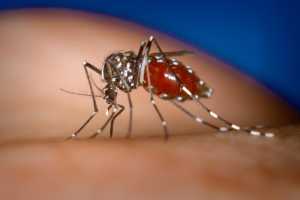
23 Jan Chikungunya Vaccine Candidate: Valneva Reports Positive Phase 1 Interim Results
MedicalResearch.com Interview with:
![]() Thomas Lingelbach
Thomas Lingelbach
President & CEO of Valneva
MedicalResearch.com: What is the background for this study? Would you briefly explain the significance of Chikungunya disease?
Response: Chikungunya is a mosquito-borne viral disease caused by the Chikungunya virus (CHIKV), a Togaviridae virus, transmitted by Aedes mosquitoes. The chikungunya virus causes clinical illness in 72-92% of infected humans around four to seven days after an infected mosquito bite. People infected with chikungunya may suffer from acute onset of fever, debilitating joint and muscle pain, headache, nausea and rash, potentially developing into long-term, serious health impairments such as visual, neurological, heart and gastrointestinal manifestations that in some extreme cases can lead to fatalities.

This photograph depicts a female Aedes albopictus mosquito as she was feeding on a human host. You can see the red, needle-like proboscis that had penetrated the skin, and was filled with the host’s blood, which had filled her abdomen. Ae. albopictus is known to be a vector for a number of arboviral diseases, including yellow fever, dengue fever, and Chikungunya fever.
CDC/ James Gathany
Chikungunya outbreaks have been reported in Asia, Africa, the Americas and Europe. As of 2017, there have been more than one million reported cases in the Americas. The medical burden is expected to grow as the CHIKV primary mosquito vectors continue to further spread geographically.
Currently there are no preventive vaccines against Chikungunya making it a major threat to public health.
We set out to develop VLA1553, a live-attenuated vaccine candidate, as a potential solution to the growing unmet need chikungunya poses. Our hope is that having a preventative vaccine for chikungunya will allow people living in endemic areas to have peace of mind while enjoying the outdoors.
MedicalResearch.com: What are the main findings?
Response: In the Phase 1interim study, VLA1553 was shown to have both a positive safety profile and excellent immunogenicity after a single-shot vaccination with a 100% seroconversion rate. The pooled safety profile of all groups was found to be acceptable, which supports further development of the vaccine candidate. No serious adverse events nor adverse events of special interest were reported up to Day 28 and the local tolerability was considered excellent.
MedicalResearch.com: What should readers take away from your report?
Response: Chikungunya is a growing public health threat that poses a large unmet medical need for a defensive vaccine. Vaccination is the most effective method of prevention against an infectious disease such as chikungunya. We are working to deliver both a safe and effective vaccine against chikungunya as quickly as possible in order to help reduce the global burden.
MedicalResearch.com: What recommendations do you have for future research as a result of this work?
Response: The next steps for VLA1553 include a Phase 1 revaccination that is expected by mid-year. With the help of the FDA Fast Track designation, we will work closely with the FDA to create a development strategy, so that we can deliver an effective and safe vaccine as quickly as possible.
MedicalResearch.com: What are the next steps as result of this work?
Response: The next steps for VLA1553 include a Phase 1 revaccination that is expected by mid-year. With the help of the FDA Fast Track designation, we will work closely with the FDA to create a development strategy, so that we can deliver an effective and safe vaccine as quickly as possible.
MedicalResearch.com: Is there anything else you would like to add?
Response: In addition to VLA1553, our team is also developing a vaccine candidate for Lyme disease, VLA15. Currently, there is no vaccine available to protect humans against Lyme disease, the most common tick-borne disease in the Northern Hemisphere, and there is significant unmet need for a vaccine as the disease footprint widens. Our vaccine candidate, VLA15, is designed to protect people against Lyme disease and has the potential to be the only EMA/FDA-approved vaccine on the market that can prevent Lyme disease transmission to humans. VLA15 is currently being tested in a Phase 2 clinical study to determine the optimal dose and dose schedule of VLA15. In addition to VLA15, we have a strong portfolio of commercial and developmental vaccine assets that help position us a leading vaccine biotech.
Citations:
VALNEVA REPORTS POSITIVE PHASE 1 INTERIM RESULTS FOR ITS CHIKUNGUNYA VACCINE CANDIDATE
[wysija_form id=”3″]
[last-modified]
The information on MedicalResearch.com is provided for educational purposes only, and is in no way intended to diagnose, cure, or treat any medical or other condition. Always seek the advice of your physician or other qualified health and ask your doctor any questions you may have regarding a medical condition. In addition to all other limitations and disclaimers in this agreement, service provider and its third party providers disclaim any liability or loss in connection with the content provided on this website.
Last Updated on January 23, 2019 by Marie Benz MD FAAD
